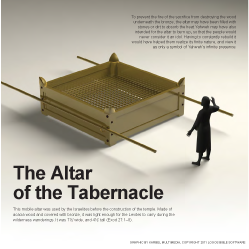9:1–24 Following the seven-day ordination period, Aaron offers the inaugural sacrifices for worship at the tabernacle. Everything offered in this chapter is a representative example (in a way) of the sacrifices and offerings detailed in Lev 1–7. Aaron and his sons follow the prescribed procedures for the purification (sin) offering (ch. 4), the burnt offering (ch. 1), the grain offering (ch. 2), and the peace (fellowship) offering (ch. 3). This passage shows the instructions for the sacrificial system being put in practice. The continuity between ch. 9 and Lev 10 suggests the events all occurred on the one occasion—the inauguration of the tabernacle that immediately followed the ordination of Aaron and his sons. |
9:1 on the eighth day This ceremony marks the culmination of the consecration of the priests, the altar, and the tabernacle after the seven days of waiting described in 8:35.
Israel’s elders The elders were the leaders of their respective tribes or clans. See note on Exod 3:16.
9:2 Take for yourself Aaron must offer sacrifices to atone for himself first and then for the community. The distinction between offerings for the priests themselves and those for the community as a whole is also seen in the ceremony for the Day of Atonement (compare Lev 16:3–6).
(compare Lev 16:3–6).
9:3 a he-goat as a sin offering According to 4:22–26, this was the purification (sin) offering (chatta’th in Hebrew) sacrifice required for a community leader’s inadvertent sin. Here the male goat is apparently brought for the entire community (v. 5). However, a male goat is brought for the community purification offering on the Day of Atonement (16:15). The offering required for a special occasion such as the inauguration of the tabernacle or the Day of Atonement may have differed from the usual offering.
9:6 the glory of Yahweh Refers to Yahweh’s visible appearance coming to indicate His presence at the tabernacle. Compare Exod 24:9–11, 16–17; 33:18, 22.
9:7 make atonement See note on Lev 4:20. The wording here parallels 16:15–17 with respect to the actions of the high priest on the Day of Atonement.
9:8 Aaron approached the altar Aaron presented the sacrifices on the altar as instructed, beginning with the purification (sin) offering for himself.
9:9 presented the blood The handling of the blood for this offering also differs from the instructions in 4:1–12 concerning the purification (sin) offering for the priest.
9:11 he burned with fire outside the camp Following the instructions from 4:12 (compare Exod 29:14).
9:15 like the first one The purification (sin) offering for the people was handled just like the one for the priest except that Aaron’s was a bull and the people’s is a goat. Presumably the blood was handled the same way as well, meaning it was applied to the altar of burnt offering only and not taken inside the tent of meeting (see note on Lev 9:9; compare 10:18).
9:16 according to the regulation Aaron’s actions for the burnt offerings, the grain offering, and the peace (fellowship) offerings align with the instructions for those offerings outlined earlier in chs. 1–3.
9:18 on the altar all around See note on 3:2.
9:21 a wave offering See note on 7:30.
9:24 a fire went out from before Yahweh The visible manifestation of divine presence in v. 23 becomes a visible manifestation of divine power. This action made it clear that Yahweh’s presence was truly there in the tabernacle. Yahweh manifests His power in a similar way for Elijah, demonstrating that He alone is truly God when He sends fire from heaven to consume Elijah’s sacrifices (1 Kgs 18:38–39).

|
About Faithlife Study BibleFaithlife Study Bible (FSB) is your guide to the ancient world of the Old and New Testaments, with study notes and articles that draw from a wide range of academic research. FSB helps you learn how to think about interpretation methods and issues so that you can gain a deeper understanding of the text. |
| Copyright |
Copyright 2012 Logos Bible Software. |
| Support Info | fsb |
 Loading…
Loading…



